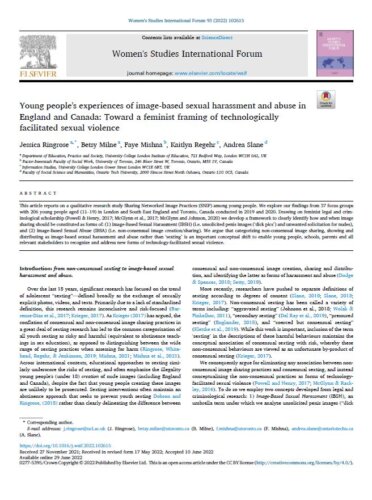Sexting
Young people’s experiences of image-based sexual harassment and abuse in England and Canada: Toward a feminist framing of technologically facilitated sexual violence
Open Access: Yes.
Abstract
This article reports on a qualitative research study Sharing Networked Image Practices (SNIP) among young people. We explore our findings from 37 focus groups with 206 young people aged (11–19) in London and South East England and Toronto, Canada conducted in 2019 and 2020. Drawing on feminist legal and criminological scholarship (Powell & Henry, 2017; McGlynn et al., 2017; McGlynn and Johnson, 2020) we develop a framework to clearly identify how and when image sharing should be constituted as forms of: (1) Image-Based Sexual Harassment (IBSH) (i.e. unsolicited penis images (‘dick pics’) and unwanted solicitation for nudes), and (2) Image-Based Sexual Abuse (IBSA) (i.e. non-consensual image creation/sharing). We argue that categorizing non-consensual image sharing, showing and distributing as image-based sexual harassment and abuse rather than ‘sexting’ is an important conceptual shift to enable young people, schools, parents and all relevant stakeholders to recognize and address new forms of technology-facilitated sexual violence.
Relevance
“Girls’ experiences of IBSH—i.e., receiving unsolicited sexual images and unwanted solicitation for sexual images—were widespread and normalized.”
The “most common senders of unsolicited dick pics were adult strangers.” In England, girls “commonly discussed receiving unwanted requests for nude images from older men.”
“A common trend across both contexts was girls’ experiences of IBSH from those they identified as boys under 18 who they only knew via social media, i.e., not known in person.”
Because “these practices are so normalized, it was the exception for participants to understand them as forms of harassment. By categorizing these forms of solicitation as technologically facilitated sexual violence, and specifically image-based sexual harassment including being propositioned (sometimes through being sent a dick pic or masturbation video) and then further aggression (being blocked, getting additional negative comments or being publicly shamed) if they do not comply, we can better identify these practices as harmful and can better strategize how to support young people to manage these experiences.”
“We found that the saving or screenshotting of images with the intent to share them beyond the intended recipient” – what is image-based sexual abuse – “was normalized among boys and girls, but understood to be more likely to be perpetrated by boys.”
“When discussing the experiences of girls and boys who have had their image shared, participants concurred that girls faced greater [negative and shaming] social consequences.”
It is important to classify these practices not as ‘sexting’ but as “image-based sexual abuse (IBSA)” and “image-based sexual harassment (IBSH).”
Note: The authors of this study did not tie these forms of gendered sexual harassment and abuse to pornography, which is the source of these forms of sexual violence.
Citation
Ringrose, J., Milne, B., Mishna, F., Regehr, K., & Slane, A. (2022). Young people’s experiences of image-based sexual harassment and abuse in
England and Canada: Toward a feminist framing of technologically facilitated sexual violence. Women’s Studies International Forum, 92, Article 102615. https://doi.org/10.1016/j.wsif.2022.102615

